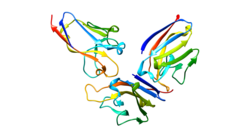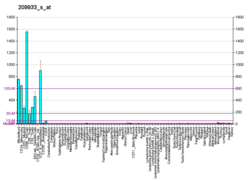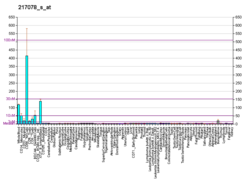
KNOWPIA
WELCOME TO KNOWPIA
Summary
CD300A (Cluster of Differentiation 300A) is a human gene.[4]
| CD300A | |||||||||||||||||||||||||||||||||||||||||||||||||||
|---|---|---|---|---|---|---|---|---|---|---|---|---|---|---|---|---|---|---|---|---|---|---|---|---|---|---|---|---|---|---|---|---|---|---|---|---|---|---|---|---|---|---|---|---|---|---|---|---|---|---|---|
 | |||||||||||||||||||||||||||||||||||||||||||||||||||
| |||||||||||||||||||||||||||||||||||||||||||||||||||
| Identifiers | |||||||||||||||||||||||||||||||||||||||||||||||||||
| Aliases | CD300A, CLM-8, CMRF-35-H9, CMRF-35H, CMRF35-H, CMRF35-H9, CMRF35H, CMRF35H9, IGSF12, IRC1, IRC1/IRC2, IRC2, IRp60, CD300a molecule | ||||||||||||||||||||||||||||||||||||||||||||||||||
| External IDs | OMIM: 606790 MGI: 2443411 HomoloGene: 48514 GeneCards: CD300A | ||||||||||||||||||||||||||||||||||||||||||||||||||
| |||||||||||||||||||||||||||||||||||||||||||||||||||
| |||||||||||||||||||||||||||||||||||||||||||||||||||
| |||||||||||||||||||||||||||||||||||||||||||||||||||
| |||||||||||||||||||||||||||||||||||||||||||||||||||
| Wikidata | |||||||||||||||||||||||||||||||||||||||||||||||||||
| |||||||||||||||||||||||||||||||||||||||||||||||||||
The CMRF35 antigen (CMRF35A; MIM 606786), which was identified by reactivity with a monoclonal antibody, is present on monocytes, neutrophils, and some T and B lymphocytes. CMRF35H is recognized by the same antibody and is distinct from CMRF35 (Green et al., 1998).[supplied by OMIM][4]
See also edit
References edit
- ^ a b c GRCh38: Ensembl release 89: ENSG00000167851 – Ensembl, May 2017
- ^ "Human PubMed Reference:". National Center for Biotechnology Information, U.S. National Library of Medicine.
- ^ "Mouse PubMed Reference:". National Center for Biotechnology Information, U.S. National Library of Medicine.
- ^ a b "Entrez Gene: CD300A CD300a molecule".
Further reading edit
- Clark GJ, Fitzpatrick S, Kuo B, et al. (2003). "CMRF-35A, CMRF-35H: potential new CD". J. Biol. Regul. Homeost. Agents. 16 (3): 233–5. PMID 12456026.
- Alvarez Y, Tang X, Coligan JE, Borrego F (2007). "The CD300a (IRp60) inhibitory receptor is rapidly up-regulated on human neutrophils in response to inflammatory stimuli and modulates CD32a (FcgammaRIIa) mediated signaling". Mol. Immunol. 45 (1): 253–8. doi:10.1016/j.molimm.2007.05.006. PMC 2000843. PMID 17588661.
- Bachelet I, Munitz A, Moretta A, et al. (2006). "The inhibitory receptor IRp60 (CD300a) is expressed and functional on human mast cells". J. Immunol. 175 (12): 7989–95. doi:10.4049/jimmunol.175.12.7989. PMID 16339535.
- Gerhard DS, Wagner L, Feingold EA, et al. (2004). "The status, quality, and expansion of the NIH full-length cDNA project: the Mammalian Gene Collection (MGC)". Genome Res. 14 (10B): 2121–7. doi:10.1101/gr.2596504. PMC 528928. PMID 15489334.
- Strausberg RL, Feingold EA, Grouse LH, et al. (2003). "Generation and initial analysis of more than 15,000 full-length human and mouse cDNA sequences". Proc. Natl. Acad. Sci. U.S.A. 99 (26): 16899–903. Bibcode:2002PNAS...9916899M. doi:10.1073/pnas.242603899. PMC 139241. PMID 12477932.
- Clark GJ, Green BJ, Hart DN (2000). "The CMRF-35H gene structure predicts for an independently expressed member of an ITIM/ITAM pair of molecules localized to human chromosome 17". Tissue Antigens. 55 (2): 101–9. doi:10.1034/j.1399-0039.2000.550201.x. PMID 10746781.
- Cantoni C, Bottino C, Augugliaro R, et al. (1999). "Molecular and functional characterization of IRp60, a member of the immunoglobulin superfamily that functions as an inhibitory receptor in human NK cells". Eur. J. Immunol. 29 (10): 3148–59. doi:10.1002/(SICI)1521-4141(199910)29:10<3148::AID-IMMU3148>3.0.CO;2-L. PMID 10540326. S2CID 8828216.
- Green BJ, Clark GJ, Hart DN (1998). "The CMRF-35 mAb recognizes a second leukocyte membrane molecule with a domain similar to the poly Ig receptor". Int. Immunol. 10 (7): 891–9. doi:10.1093/intimm/10.7.891. PMID 9701027.
- Jackson DG, Hart DN, Starling G, Bell JI (1992). "Molecular cloning of a novel member of the immunoglobulin gene superfamily homologous to the polymeric immunoglobulin receptor". Eur. J. Immunol. 22 (5): 1157–63. doi:10.1002/eji.1830220508. PMID 1349532. S2CID 23437463.
External links edit
- CD300A+protein,+human at the U.S. National Library of Medicine Medical Subject Headings (MeSH)
- CD300a, Bernholtz - The Possible End to Asthma - The Future of Things article
- Human CD300A genome location and CD300A gene details page in the UCSC Genome Browser.
- Overview of all the structural information available in the PDB for UniProt: Q9UGN4 (Human CMRF35-like molecule 8 (CD300A)) at the PDBe-KB.
This article incorporates text from the United States National Library of Medicine, which is in the public domain.






